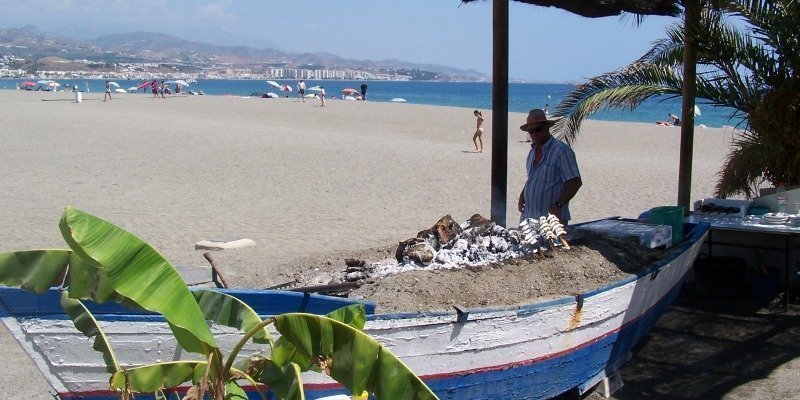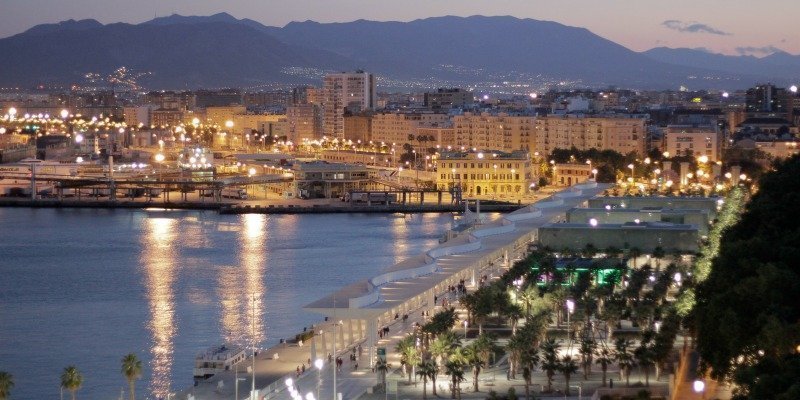TORREMOLINOS
Torremolinos (Spanish pronunciation: [toremoˈlinos]) is a municipality on the Costa del Sol of the Mediterranean, immediately to the west of the city of Málaga, in the province of Málaga in the autonomous community of Andalusia in southern Spain. It belongs to the comarca of Costa del Sol Occidental. Once a poor fishing village before the growth in tourism began in the late 1950s, Torremolinos was the first of the Costa del Sol resorts to be developed.
It is located on the western shore of the Bay of Málaga and in front of the Sierra de Mijas. It lies at a distance of 13 km from Málaga and is served by the A-7 motorway, which bypasses the city to the north, the Renfe commuter train and Avanzabus.
In 2013 it had 69,389 inhabitants, making it the sixth largest city in the province. The township has an area of 20 km² and a population density of 3153.85 inhabitants/km², which is multiplied during the summer months.
It is particularly popular with British, Irish and Scandinavian tourists and has a large British expatriate population.
Areas of the town are spotted with older high-rise residential buildings and hotels but height limits on new developments and a significant number of original old town properties, have kept the town centre much more open than other popular resorts such as Benidorm and Fuengirola.
The beach which extends for nearly 8 kilometres, has cycle and skating lanes alongside the fully illuminated promenade and features many chiringuitos and beach bars. The Eastern end of the beach known as Los Alamos has live dance music events throughout the Summer. The easternmost parts of the beach have kite surfing and windsurfing except under the flight path of the airport.
There are two separate beach lifts, a wheelchair accessible footpath and steps from the town centre to the beach.
Though there are many parking spaces on the beach road, it is almost impossible to park in the Summer months. The town centre does have many underground car parks however.
In addition to its tourism sector, Torremolinos is known locally for its vibrant and liberal nightlife, particularly its numerous bars and clubs catering to the LGBT community.[1] Torremolinos will be hosting World Pride in 2017 in conjunction with Madrid.
Turistic "Boom"
During the first half of the 19th century the town was rebuilt and by 1849 there were 14 mills, a fuller mill p Kraft paper and 785 inhabitants. With the demise of the mill, Torremolinos became a small fishing village until the end of the 1950s when it became one of the first tourist centre in Costa del Sol. In the 1950s many celebrities visited Torremolinos such as Grace Kelly, Ava Gardner, Marlon Brando, Orson Welles and Frank Sinatra.
In 1959 Pez Espada hotel was opened, the first luxury hotel along the coast. In the following years, new hotels, nightclubs and others tourist establishments changed the face of the town and its beaches. By the year 1965, Torremolinos had become consolidated as a major tourist destination.
Gastronomy
In Torremolinos you can find their famous Chiringuitos (restaurants on the beach) from the Carihuela, Bajondillo, Playamar, Costa Lago. At these bars you can eat fresh fish and seafood typical of the area; some of their people were traditionally fishermen.
By 2012 McDonald's in the heart of Torremolinos had closed its doors, following KFC and Pizza Hut not least because of competition from native companies such as Telepizza and Matahambre. Only Burger King remains.
Following the 2016 pedestrianisation of Plaza Costa del Sol, McDonald's, along with several other companies, have decided to reopen with the benefit a large terraces.
Famous residents
-Danny La Rue World-famous female impersonator.
-Damian Quintero Karate Champion of the World
-Alvin Karpis (1907–1979), Depression-era outlaw, lived his last years in Torremolinos after being released from jail by US authorities.
-Gustavo Thorlichen, photographer of the Peróns and Che Guevara.
-Nina Zhivanevskaya, bronze medal winner for Spain in 100 metre backstroke at the 2000 Summer Olympics.
-Brendan Sheerin, presenter (tour guide) on the British television reality show, Coach Trip.
From Wikipedia https://en.wikipedia.org/wiki/Torremolinos

MÁLAGA
Malaga Main Sights
The old historic centre of Málaga reaches the harbour to the south. In the north it is surrounded by mountains, the Montes de Málaga (part of the Baetic Cordillera) lying in the southern base of the Axarquía hills, and two rivers, the Guadalmedina – the historic center is located on its left bank – and the Guadalhorce, which flows west of the city into the Mediterranean.
The oldest architectural remains in the city are the walls of the Phoenician city, which are visible in the cellar of the Museo Picasso Málaga.
The Roman theatre of Málaga, which dates from the 1st century BC, was rediscovered in 1951.[20]
The Moors left posterity the dominating presence of the Castle of Gibralfaro, which is connected to the Alcazaba, the lower fortress and royal residence. Both were built during the Taifa period (11th century) and extended during the Nasrid period (13th and 14th centuries). The Alcazaba stands on a hill within the city. Originally, it defended the city from the incursions of pirates. Later, in the 11th century, it was completely rebuilt by the Hammudid dynasty.[21] Occupying the eastern hillside that rises from the sea and overlooks the city, the Alcazaba was surrounded by palms and pine trees.
Like many of the military fortifications that were constructed in Islamic Spain, the Alcazaba of Málaga featured a quadrangular plan. It was protected by an outer and inner wall, both supported by rectangular towers, between which a covered walkway led up the slope to the Gibralfaro (this was the only exchange between the two sites). Due to its rough and awkward hillside topography, corridors throughout the site provided a means of communications for administrative and defensive operations, also affording privacy to the palatial residential quarters.
The entrance of the complex featured a grand tower that led into a sophisticated double bent entrance. After passing through several gates, open yards with beautiful gardens of pine and eucalyptus trees, and the inner wall through the Puerta de Granada, one finds the 11th and 14th century Governor's palace. It was organised around a central rectangular courtyard with a triple-arched gateway and some of the rooms have been preserved to this day. An open 11th century mirador (belvedere) to the south of this area affords views of the gardens and sea below. Measuring 2.5 square metres, this small structure highlighted scalloped, five-lobed arches. To the north of this area were a waterwheel and a Cyclopean well (penetrating forty metres below ground), a hammam, workshops and the monumental Puerta de la Torre del Homenaje, the northernmost point of the inner walls. Directly beyond was the passage to the Gibralfaro above.
The Church of Santiago (Saint James) is an example of Gothic vernacular Mudéjar, the hybrid style that evolved after the Reconquista incorporating elements from both Christian and Islamic tradition. Also from the period is the Iglesia del Sagrario, which was built on the site of the old mosque immediately after the city fell to Christian troops. It boasts a richly ornamented portal in the Isabeline-Gothic style, unique in the city.
The Cathedral and the Episcopal Palace were planned with Renaissance architectural ideals but there was a shortfall of building funds and they were finished in Baroque style.
The Basílica y Real Santuario de Santa María de la Victoria, built in the late 17th century, has a chapel in which the vertical volume is filled with elaborate Baroque plasterwork.
Other sights include:
Walls. Phoenician, Roman, Byzantine, Arab and Spanish remains of the defensive compounds of the city.
La Concepción, botanical and historical garden.
Church of the Sacred Heart.
San Felipe Neri Church.
Church of the Holy Martyrs.
Atarazanas Market.
Palm grove and Muelle Uno. Port of Málaga.
Anglican Cemetery of St. George.
San Miguel Cemetery.
La Malagueta bullring.
Pedregalejo, old fishing district.
(Texto de Wikipedia https://en.wikipedia.org/wiki/M%C3%A1laga )


